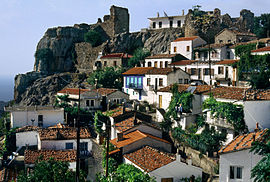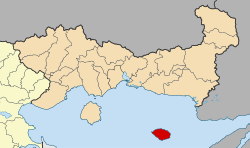
Back ሳሞትራቄ Amharic سمدرك Arabic ساموثراكى ARZ Samothrace BCL Самафракія Byelorussian Самотраки Bulgarian Samothraki Breton Samotràcia Catalan Samothrace Island CEB Samothraké Czech
Samothrace
Σαμοθράκη | |
|---|---|
 View of the Chora (Samothraki) | |
| Coordinates: 40°27′00″N 25°35′15″E / 40.45000°N 25.58750°E | |
| Country | Greece |
| Administrative region | Eastern Macedonia and Thrace |
| Regional unit | Evros |
| Government | |
| • Mayor | Athanasios Vitsas[1] (since 2014) |
| Area | |
• Municipality | 178.0 km2 (68.7 sq mi) |
| Highest elevation | 1,611 m (5,285 ft) |
| Lowest elevation | 0 m (0 ft) |
| Population (2021)[2] | |
• Municipality | 2,596 |
| • Density | 15/km2 (38/sq mi) |
| Demonym | Samothracian |
| Time zone | UTC+2 (EET) |
| • Summer (DST) | UTC+3 (EEST) |
| Postal code | 680 02 |
| Area code(s) | 25510 |
| Vehicle registration | ΕΒ |
| Website | www.samothraki.gr |

Samothrace (also known as Samothraki; Greek: Σαμοθράκη, [samoˈθraci]) is a Greek island in the northern Aegean Sea. It is a municipality within the Evros regional unit of Thrace. The island is 17 km (11 mi) long, 178 km2 (69 sq mi) in size and has a population of 2,596 (2021 census).[2] Its main industries are fishing and tourism. Resources on the island include granite and basalt. Samothrace is one of the most rugged Greek islands, with Mt Saos and its highest peak, Fengari, rising to 1,611 m (5,285 ft). The Winged Victory of Samothrace statue, which is now displayed at the Louvre in Paris, was found on the island.
- ^ "Municipality of Samothrace, Municipal elections – October 2023". Ministry of Interior.
- ^ a b "Αποτελέσματα Απογραφής Πληθυσμού - Κατοικιών 2021, Μόνιμος Πληθυσμός κατά οικισμό" [Results of the 2021 Population - Housing Census, Permanent population by settlement] (in Greek). Hellenic Statistical Authority. 29 March 2024.

